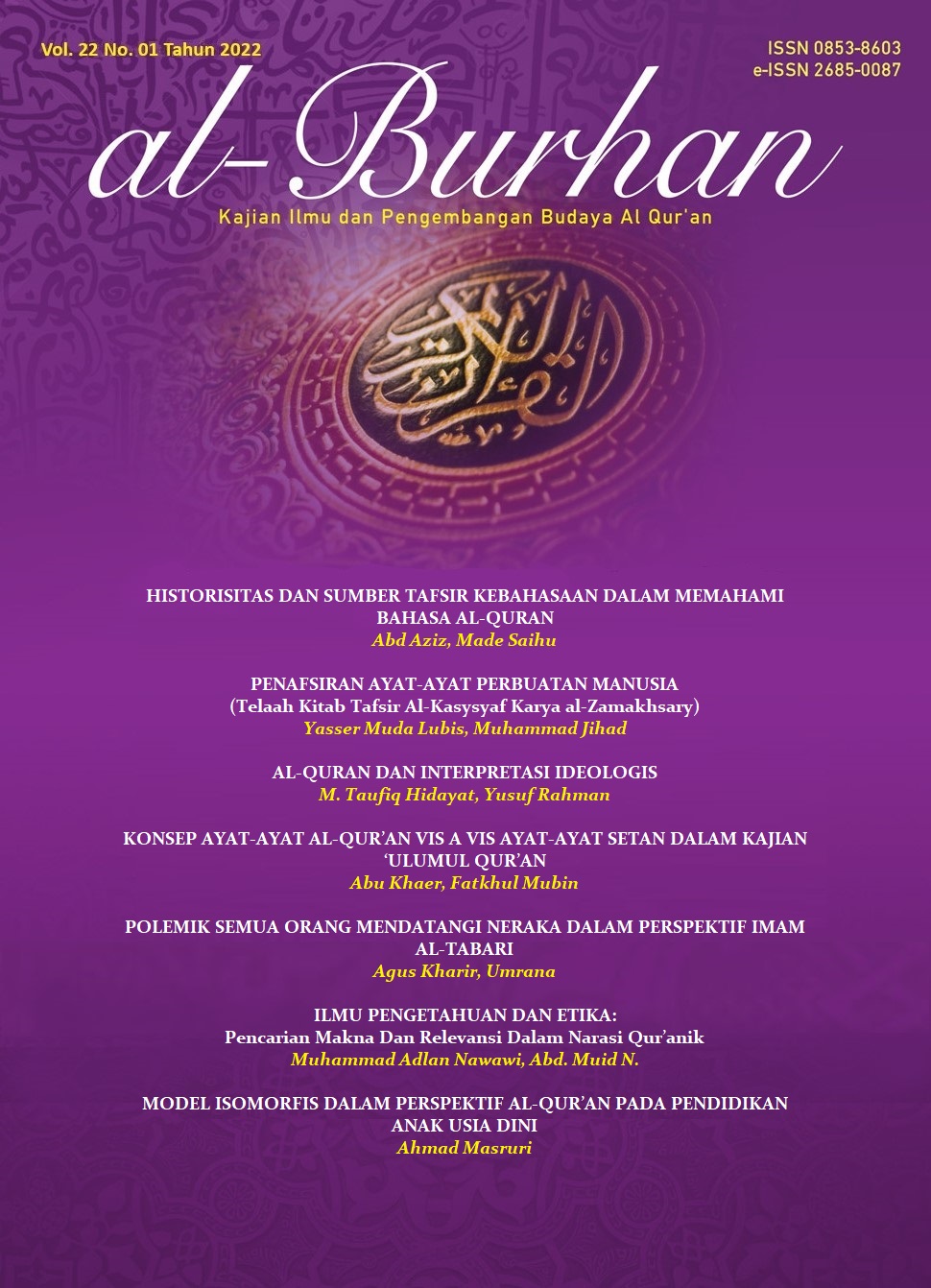POLEMIK SEMUA ORANG MENDATANGI NERAKA DALAM PERSPEKTIF IMAM AL-TABARI
Keywords:
The Polemic, Hell, Imam al-TabariAbstract
This article describes about hell in various suras in the Qur'an, one of which is Surah Maryam verses 71 and 72. Unlike other verses, this verse states that everyone will come to hell whether he is a disobedient person or a believer. Regarding this verse, there are differences of opinion on the meaning of the word وَارِدُهاَ which means to come to him. Some interpret it with the meaning of entering. While some others interpret it with the meaning of passing. Imam al-Tabari is one of the commentators who provides a fairly detailed interpretation of the verse. The author uses a qualitative method of literature (library research) with the theory of tahlili. The author conducts a search and collects various data related to the variables studied, then analyzes interpretively and descriptively on the data that has been collected. The meaning of the word وَارِدُهاَ in this verse according to al-Tabari is al-Mururu or passing, that is, all believers or unbelievers will pass through hell, namely through sirat that lies above hell. But among them there are those who survived through it and some who fell into hell. Regarding the criteria for those who are saved on the journey through the sirat, Imam al-Tabari stated that they are pious people. As for the criteria for those who are allowed to fall into hell according to al-Tabari, they are those who wrong themselves
References
Abdul Baqi, Muhammad Fuad. Sahih Muslim. terj. Rohimi Ghufron. Jilid 1. Jakarta: Pustaka al-Sunnah, 2010.
———. Sahih Muslim. terj. Rohimi Ghufron. Jilid 4. Jakarta: Pustaka al-Sunnah, 2010.
al-Asfahani, Abu Nu’aim. Hilyah Al-’Auliya. terj. Abdullah al-Minsari, Muhammad Ahmad Isa, dan Muhammad Abdullah al-Hindi. jilid 8. Jakarta: Pustaka Azzam, 2000.
al-Amir Ashun’ani, Muhammad Ali Ismail. Perbedaan Ulama Salaf Dan Khalaf Tentang Keabadian Neraka. terj. Karman. Jakarta: Pustaka Azzam, 2004.
Aziz, Abdul. Hari Kiamat, Hari Akhir, Hari Pembalasan. Surabaya: PT. Bina Ilmu, 1986.
al-Darimi, Abdullah bin Abdurrahman bin al Fadhl bin Bahram. Musnad Al-Darimi. Riyadh: Dar al-Mughni li al-Nasyri wa al-Tauzi’, 2000.
al-Hajjaj, Abu Husain Muslim. Sahih Muslim. Jilid 1. Beirut: Dar al-Kutub al-’Ilmiyah, 1991.
Kementrian Agama RI. Al-Qur’an Dan Tafsirnya (Edisi Yang Disempurnakan). Jilid 4. Jakarta: Widya Cahaya, 2011.
———. Al-Qur’an Dan Tafsirnya (Edisi Yang Disempurnakan). Jilid 10. Jakarta: Widya Cahaya, 2011.
———. Al-Qur’an Dan Tafsirnya (Edisi Yang Disempurnakan). Jilid 6. Jakarta: Widya Cahaya, 2011.
Muhammad, Abu Ja’far. Tafsir Al-T{abari>. terj. Ahsan Askan. Jilid 17. Jakarta: Pustaka Azzam, 2009.
———. Tafsir Al-Tabari. terj. Ahsan Askan. Jilid 1. Jakarta: Pustaka Azzam, 2009.
Mustaqim, Abdul. Metode Penelitian Al-Qur’an Dan Tafsir. cet. I. Yogyakarta: Idea Press, 2014.
Roidah. Gambaran Neraka Menurut Al-Qur’an Dan Hadis. Jakarta: PT. Elex Media Komputindo, 2017.
Shihab, M. Quraish. Kehidupan Setelah Kematian (Surga Yang Di Janjikan al-Qur’an). Jakarta: Lentera Hati, 2004.
Supadie, Didiek Ahmad. Pengantar Studi Islam. Jakarta: Rajawali Press, 2012.
Suryadilaga, M. al-fatih, dkk. Metodelogi Ilmu Tafsir. Yogyakarta: Teras, 2005.
al-Tabari, Abu Ja’far Muhammad Ibnu Jarir. Tafsir Al-Tabari. Juz 15. Turki: Markazu al-Buhutsu wa al-Dirasatu al-‘Arabiyatu wa al-Islamiyatu, 2001.

1_(1).jpg)
